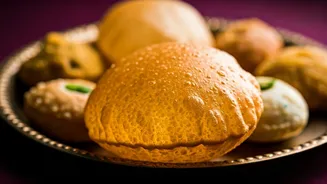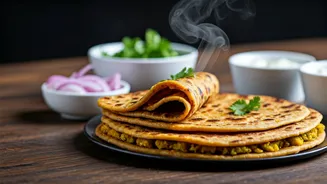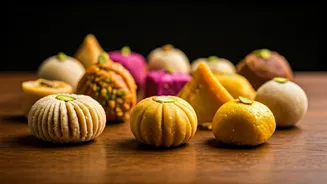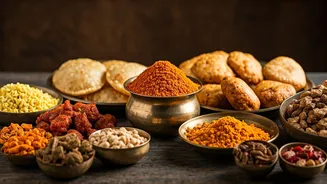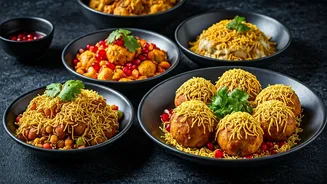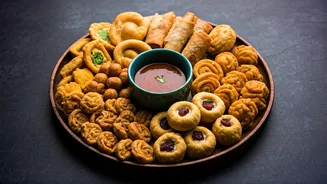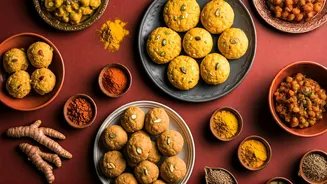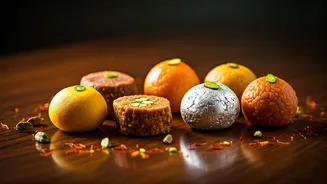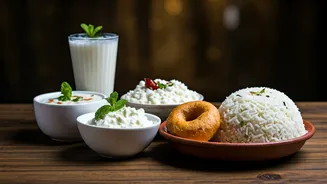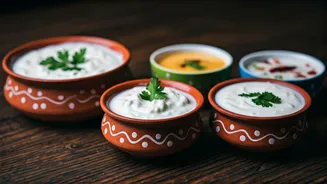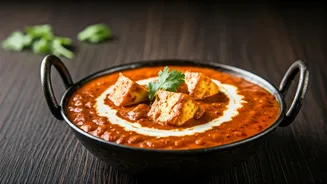Introduction: Poori's Legacy
Poori, a deep-fried Indian bread, is a staple of Indian cuisine, particularly during celebrations. Its origins lie in the Indian subcontinent, where it
has evolved over centuries. During Diwali, pooris take center stage, becoming a symbol of joy and togetherness. They are often paired with various curries and sweets, making them a festive favorite. Families often gather to make and enjoy pooris, creating lasting memories. The simplicity of ingredients and the versatility of flavors have cemented poori's place in Indian culinary traditions. The aroma of freshly fried pooris wafts through homes, signaling the start of the Diwali festivities. Pooris are not merely food; they are an integral part of the cultural fabric of India, connecting generations through shared meals and cherished traditions. Each region in India may have a unique take on the poori, using local ingredients and adapting cooking styles. The preparation of pooris often involves the entire family, passing down recipes and techniques from elders to the younger generation, which creates a sense of continuity and communal harmony.
The Classic: Plain Poori
Plain poori, the most fundamental form, is prepared using only wheat flour (atta), water, and a pinch of salt. The dough is kneaded to a firm consistency, then rolled into small, round discs, and deep-fried in hot oil until they puff up. The simplicity of this poori highlights the quality of the ingredients. When fried correctly, the plain poori balloons, creating a light and airy texture. It serves as a blank canvas for various curries and gravies, pairing well with almost any dish. The golden-brown color and crispy exterior, combined with a soft interior, offer a delightful contrast in every bite. This poori is incredibly versatile and can be enjoyed for breakfast, lunch, or dinner. It is a testament to the fact that great food doesn't require complex ingredients; instead, it relies on mastering simple techniques.
Flavorful: Masala Poori
Masala poori introduces a burst of flavor by incorporating spices directly into the dough. Common spices include turmeric, cumin, coriander, and chili powder. These spices are mixed with the atta and water to create a fragrant dough that lends a distinctive flavor to the poori. The spices not only enhance the taste but also add a touch of color, often resulting in a slightly yellow or reddish hue. Masala poori pairs especially well with spicy curries and chutneys. The spicy notes within the poori complement the rich and complex flavors of Indian dishes. Making masala poori offers a way to customize the flavor profile of the meal. The level of spiciness can be adjusted to individual preferences, making it a perfect choice for those who enjoy a little extra kick. It can also include additional ingredients, such as finely chopped onions or green chilies, further enhancing its appeal.
The Spiced: Methi Poori
Methi poori is infused with fresh or dried fenugreek leaves (methi), which impart a unique, slightly bitter flavor and aroma. The addition of methi brings health benefits and a distinctive taste. The leaves are finely chopped and mixed into the dough along with spices like turmeric and red chili powder. This combination results in a poori with a slightly green hue and an aromatic profile. Methi poori is often enjoyed as a breakfast item or a side dish. The slight bitterness of the methi balances the richness of the oil and creates a well-rounded flavor. This poori offers a healthier option, thanks to the addition of fenugreek, known for its medicinal properties. The flavor of methi adds a welcome complexity to the poori, making it a delightful option for those looking to try something different during Diwali.
Sweet Delight: Malpua Poori
Malpua poori is a sweet variation designed for dessert or as a sweet component to the meal. This involves incorporating ingredients like sugar, milk, and cardamom into the dough. The mixture is then deep-fried until golden brown, resulting in a soft, pancake-like poori. The Malpua poori is often drizzled with sugar syrup or honey, amplifying the sweetness. This poori offers a delightful contrast to the savory dishes typically eaten during Diwali. It's an excellent way to satisfy a sweet craving after a flavorful meal. The soft and fluffy texture, combined with the sweet syrup, creates a memorable treat. This poori highlights the versatility of the dish, showing it can be adapted to both savory and sweet dishes. The addition of cardamom provides an aromatic touch, making the experience even more enjoyable.
The Filled: Stuffed Poori
Stuffed poori is a creative variation that involves filling the poori with savory fillings before frying. These fillings can vary widely, including spiced mashed potatoes, lentils, or a mixture of vegetables and spices. The process is a little more involved, requiring the filling to be carefully sealed within the dough before frying. The result is a poori that bursts with flavor when eaten. Stuffed poori can serve as a complete meal on its own, providing a balance of carbohydrates, proteins, and spices. It's a great way to use up leftover vegetables or curries, reducing food waste. The versatility of stuffed poori allows for culinary experimentation; any flavor profile can be explored based on the choice of filling. The stuffed poori adds an element of surprise to the meal, with each bite offering a different taste experience.
Regional: Bhatura's Cousin
While not technically a poori, bhatura is closely related and often enjoyed alongside it. Bhatura differs in its preparation, typically made with all-purpose flour (maida) and sometimes includes yogurt, which gives it a softer and fluffier texture. The dough is allowed to ferment, resulting in a slightly tangy flavor. Bhatura is typically larger and thicker than poori, and it is deep-fried to a golden-brown color, which puffs up significantly. This dish is usually served with chole (chickpea curry), making it a popular North Indian combination. The softer texture of bhatura creates a contrast to the crispy poori. It complements the spicy and flavorful chole. Bhatura provides a unique taste and texture experience that differs from traditional poori. It is a satisfying and flavorful treat, suitable for festive occasions and everyday meals.
Innovative: Palak Poori
Palak poori incorporates spinach (palak) into the dough, providing both color and nutritional benefits. The spinach is typically pureed and added to the atta along with spices like ginger and green chilies. This creates a vibrant green poori, offering a hint of freshness. Palak poori is an excellent way to sneak extra vegetables into your diet, especially for children. The mild flavor of the spinach complements the other spices. It pairs well with various curries and dips, bringing a different color palette to the meal. The soft texture and subtle flavors make this an easy favorite. It’s a great way to add a healthy spin to a traditional dish, providing vitamins and nutrients, making it a valuable addition to any festive menu.
The Spiced: Ajwain Poori
Ajwain poori includes ajwain (carom seeds) into the dough, which are known for their digestive properties and distinctive flavor. Ajwain seeds offer a unique aroma, which adds another dimension. The seeds are mixed with the atta, salt, and water to create a dough that, when fried, emanates a savory fragrance. Ajwain poori is often eaten for its digestive benefits. It is a good option for those looking to avoid indigestion during festive meals. The flavor of ajwain balances the richness of the fried dough, making it a balanced treat. It can also provide a unique taste experience. The combination of ajwain with other spices complements several dishes. It is a popular choice for those who want a digestive-friendly option.
Gluten-Free: Ragi Poori
Ragi poori provides a gluten-free alternative using ragi flour (finger millet). This flour offers a nutritional boost and a slightly earthy flavor. Ragi flour is mixed with water and salt to form a dough, which is then rolled and fried. This poori is suitable for those with gluten sensitivities or those looking to incorporate healthier grains into their diet. The nutty flavor of ragi provides a unique taste and texture. It pairs well with a variety of curries and chutneys. It’s a great way to diversify your diet and try different grains. The high fiber content in ragi makes it a more filling and satisfying option, keeping you full for a longer time.
The Cheesy: Cheese Poori
Cheese poori incorporates grated cheese into the dough, introducing a rich and creamy element. The cheese is mixed with the atta and spices to create a flavored dough. Upon frying, the cheese melts slightly, creating a soft texture. This poori will be a hit with cheese lovers, adding to the richness of the meal. The melted cheese introduces a salty element that complements various curries and chutneys. It is a fun and modern twist on traditional recipes, making it a good choice for family gatherings. The melted cheese makes it more visually appealing. The cheesy flavor is a welcome addition, and it provides a unique taste and texture.
The Layered: Lachedar Poori
Lachedar poori, also known as layered poori, involves creating multiple layers by folding the dough. The dough is rolled out, brushed with oil, and folded multiple times, creating a flaky texture. This technique ensures that the poori puffs up beautifully during frying. Lachedar poori offers an interesting textural experience, making it a favorite for those who like to savor the texture. Each layer gives a different crunch and taste. It offers a slightly different eating experience. The layering technique also makes the poori slightly more sturdy and able to hold various curries and fillings. It is a great choice to experience various textures.
The Herbaceous: Pudina Poori
Pudina poori incorporates mint leaves (pudina) into the dough. This adds a refreshing flavor and aroma. The mint leaves are finely chopped and mixed with the dough, infusing the flavor. Pudina poori provides a cooling effect, especially appreciated during warm weather. The refreshing flavors can contrast the spices from other curries. It’s a simple way to add fresh herbs into a traditional dish, providing vitamins and antioxidants. The mint flavor adds a unique touch. It is a great option for people who love the taste of mint.
The Nutty: Peanut Poori
Peanut poori introduces roasted and ground peanuts into the dough. This offers a nutty flavor and a satisfying crunch. The peanuts are ground and mixed with the atta, contributing to the texture and flavor of the poori. Peanut poori gives a unique flavor and texture. It pairs well with spicy curries or chutneys. It offers a way to introduce healthy fats and protein to the meal. It gives a distinctive taste and texture to each bite.
The Fusion: Pizza Poori
Pizza poori combines Indian and Italian culinary traditions by including pizza-like toppings. The dough is topped with tomato sauce, cheese, and vegetables. Then, the toppings are placed on the dough before frying. This offers a fusion of flavors and is great for people who like both cuisines. Pizza poori provides an innovative and playful approach to cooking. It is a delightful blend of cuisines. It is a great choice for family gatherings and parties.
